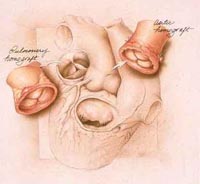toh
Homograft Valve Replacement Program
 The Homograft Valve Replacement Program was established at the University of Ottawa Heart Institute on January 18, 1987. Currently, there have been over 140 homografts performed at the Heart Institute. There are now approximately 20 homograft valve replacements done a year.
The Homograft Valve Replacement Program was established at the University of Ottawa Heart Institute on January 18, 1987. Currently, there have been over 140 homografts performed at the Heart Institute. There are now approximately 20 homograft valve replacements done a year.
Initially, replacement heart valves were developed utilizing mechanical or porcine (pig) tissue. Both mechanical and porcine heart valves represented life-saving treatment options and are still an important segment of the heart valve replacement.
However, each of these valves has certain disadvantages that preclude application for all heart valve replacement surgeries. For example, patients implanted with mechanical valves are required to take anticoagulant drugs for the remainder of their lives. Patients implanted with porcine valves can be subject to early removal of the valve due to calcification and degeneration of the porcine tissue.
The selection of a replacement valve depends on many individual patient factors (e.g. age, replacement/failure risks, risks of life-long anticoagulation, patients with a higher risk of trauma)
Indications for Valve Replacement
- Congenital malformation
- Chronic Valvular Regurgitation and/or Regurgitation
- Anatomically abnormal aortic root
Changes in Homograft Valve Replacement
Previously, there was a size practice in place whereby the size of the homograft would be matched to the patient’s (requiring replacement) annulus -3mm. As the majority of patients requiring valve replacement are young, and dilation of the annulus is part of the disease process dilation up to 34-35 mm; normal 21-26.
This dilation presents two problems:
- limited large valves available, and
- valves of 34-35mm do not exist
Now, instead of using a valve that is the same size the annulus of the recipient is shrunk to fit. A median is found between the homograft and the recipient’s annulus. This makes the finding of a homograft much easier.
Programs
- Bone Bank
- Corneal Transplant Program
- Heart Transplants
- Homograft Valve Replacement Program
Last updated on: December 30th, 2016


 To reset, hold the Ctrl key, then press 0.
To reset, hold the Ctrl key, then press 0.